#Among the Sierra Nevada
Photo
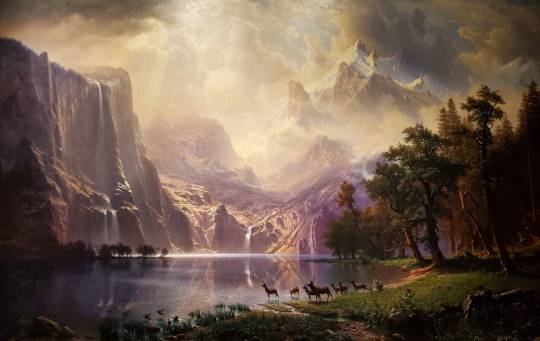
Among the Sierra Nevada
Albert Bierstadt, 1868
Smithsonian American Art Museum
293 notes
·
View notes
Text

Among the Sierra Nevada, California (Albert Bierstadt, 19th century)
71 notes
·
View notes
Text

Among the Sierra Nevada, California by Albert Bierstadt
#albert bierstadt#art#sierra nevada#california#north america#america#american#nature#mountains#mountain#lake#deers#sunlight#sky#clouds#trees
357 notes
·
View notes
Photo


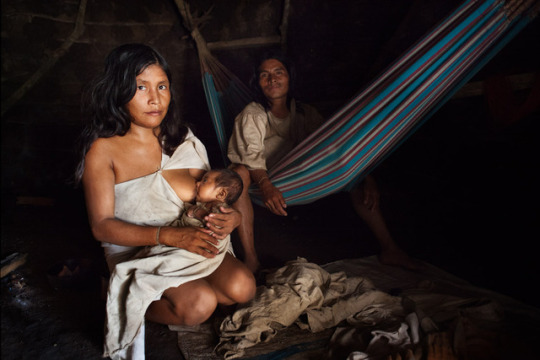


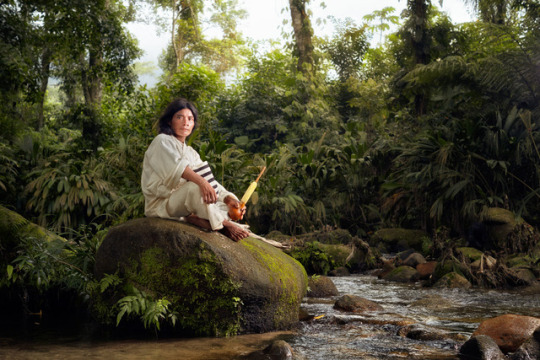
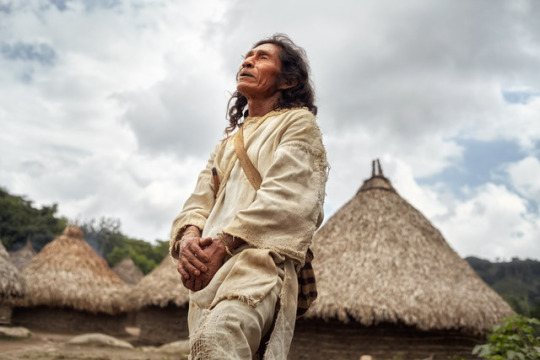


Kogi: The Indigenous people of the Colombian desert
The Kogis are one of the few indigenous people in South America who were able to maintain their pre-Columbian culture. Being a pacifistic ethnic group they never attempted to fight colonists and preferred to move to more isolated areas up the mountain, where they could continue to live their lives without much influence from western culture. They call themselves the “elder brothers” who are taking care of the “Heart of the World” (the Sierra Nevada) and protecting it from the “younger brothers” (non Kogi or Arhuaco Amerindians) who are destroying it. They believe if the “Heart of the World” get's out of balance it will affect the whole world. Having survived the Spanish colonizers, the [Colombian] colonials in the beginning of the century, the Marijuana bonanza of the 80s, the coca planting of the drug cartels and the armed conflict among guerillas and paramilitaries the Kogi are facing their biggest fear now, the destruction of “Heart of the World” due climatic changes.
- Alexander Rieser
#photography#photojournalism#indigenous#native american#indigenous people#kogi#cogui#kágaba#indígena#indígenas#pueblos indígenas
79 notes
·
View notes
Text
So 26 February 2023, Grist re-publishes a piece originally from InvestigateWest, after InvestigateWest got their hands on some sensitive emails/documents revealing that the EPA rather than fairly supervising mining companies “they’re supposed to regulate” has instead assisted the companies “by attacking researchers and smearing peer-reviewed science.” (Surprising nobody; Montana is a resource extraction colony.) The piece is titled “Newly revealed records show how the EPA sided with polluters in a small Montana mining town.”
So I’m like “oh, is this gonna be about the natural gas boom near Sidney on the North Dakota border right alongside the Bakken oil fields, an operation so big and extensive that it artificially lights up the night sky over the open prairies of the northern Great Plains in a way that, from a satellite view, makes the least densely populated and remote corner of the contiguous United States glow brightly as if it were a massive city or as if the entire region were on fire? Or is this gonna be about coal mining in the remote southeastern corner of the state in the badlands and shortgrass prairie near Crow and Cheyenne reservations, where coal companies in the Yellowstone River watershed traditionally have extracted millions from near the Powder River and Black Hills?”
But nope, it’s about Butte.
“Small Montana mining town.”
This city is still among top 5 or top 10 most culturally and economically significant cities in the state. “Significant city” would be more apt than “small town.” But beyond that.
This is the place known as “Butte, America.”
Butte was the epicenter, the home base, the foundation of the Gilded Age copper boom that electrified the world and lit the streetlights and parlors of turn-of-the-century London and New York.
All that copper wiring, that’s from Butte, or from the industries that Butte’s barons established. This was the city where mining magnates ran the Anaconda Copper Mining Company which spear-headerd the pillaging of Latin America (referenced in the “open veins of Latin America”). Anaconda established the century-long tradition of Canadian and US mining companies destroying lives and landscapes in the Andes.
By 1899, Butte was one of the most significant US cities between the Mississippi River and the Sierra Nevada. This was the home of the Copper Kings.
The Anaconda company, in 1919, completed construction on a smelter smokestack 585 feet high, which remains the tallest surviving brick structure on the planet.
The wealth of Butte in the Edwardian era is unfathomable. They had a rollercoaster. In a single year, merely just those local mines along the edge of the city could produce $23 million ($700 million today). And that doesn’t include all of the wealth stolen from Latin America or other mines in the western US.
Montana was a state that pioneered the “corporations are people” stuff. Its very statehood itself, the christening of Montana, was a gift to the Copper Kings. Every important state office was practically purchased, owned by those mining barons.
This is also why Montana was the site of some of the earliest and most important labor struggles. Because the entire state of Montana was functionally a copper mining company town. Among notable events: the 1914 Butte labor riots, the 1917 brutal assassination of Frank Little, and the 1920 “Anaconda Road Massacre” in which company guards shot and killed 17 fleeing people.
This is why, depending on who you ask, Butte is either A Company Town or A Union Town.
Butte claims to be the home of the “largest population of Irish-Americans per capita of any US city.” This may or may not be true, but this Irish influence evident in the local popularity of pasties. In the Edwardian era, Butte was also the site of an important Chinatown neighborhood and a large Chinese community.
Locally, Butte is famous/infamous for being the site of the Berkeley Pit. Or “The Pit.” The remaining scar of an open-pit copper mine. It’s one mile long, half-mile wide, almost 2,000 feet deep, filled with 900 feet of acidic water laden with cadmium, sulfuric acid, and arsenic.
Just sitting there. In the city.
“Oh, well, of course, back in the Gilded Age, in the 1890s, US businesses got a little out of control, and boom-town communities weren’t really thinking long-term, and they also didn’t know all The Science, so they allowed for the creation of, like, giant toxic death-pits in their residential areas,”
Nope. They built that open-pit mine in 1955 and operated it until 1982.
Anyway, that’s kind of what the 2023 investigative report is about. There is a newer mine (copper and molybdenum) currently open and operating in the city, right next to The Pit.
And the current mine is owned by the richest man in the state of Montana, Dennis Washington. And the EPA is like, “Don’t worry. The mine in the city is fine, it’s all good.” Because that’s what US government land management agencies do: File due diligence paperwork for land-owners while others get poisoned.
The largest open pit copper mine (by extracted volume) on the planet, and the second-deepest open-pit mine of any kind on the planet, is at Chuquicamata in the Atacama region of Chile. This mine was the property of the Anaconda company.
The towering smokestack. The Pit on the edge of town. The gaping wound at Chuquicamata. The legacy of the Copper Kings lives on with the continued theft and poisoning of those in both Montana and the Andes.
115 notes
·
View notes
Text

KINDLING ARCs are in, and they are gorgeous! 🔥 Fans of Seven Samurai and Magnificent Seven will find a lot of KINDLING familiar—the mission to save the village, the wandering warriors, the climactic battle at the end—but the setting of KINDLING takes a bit of a turn from the films. While Seven Samurai is set in Japan and Magnificent Seven takes place in Mexico, KINDLING’s setting is inspired by the Sierra Nevada (my home-mountains, my heart-range), so in its pages you’ll find the granite, the rippling rivers, the low-growing asters, the pines. The action takes place in a region known as “the northlands”—a harsh high-desert land dominated by the looming presence of a jagged range called the Candiveras—and it’s among those peaks that the kindlings find their purpose, their family, and their way back to themselves. 🏔️ It was such a joy to write about an environment that I love so dearly, and since I’m recently took a trip out there doing research for an upcoming project 👀 I thought it would be nice to take a photo of the book in the surroundings that inspired it. (What a trip it was too! I spent a whole day at this location, reading in the wilderness with nobody around at all. 📚 Pure bliss.)
Preorders for Kindling are available now, and please do remember to keep those receipts!
15 notes
·
View notes
Text
Silences
Poems of Solitude and Stillness
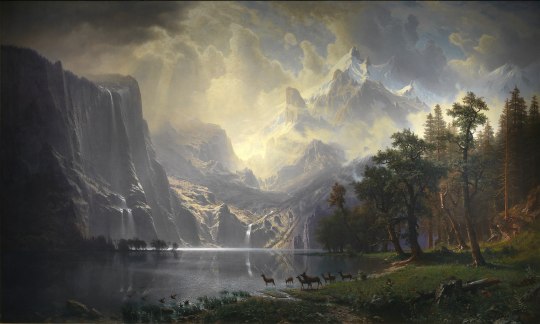
Among the Sierra Nevada Mountains by Albert Bierstadt
Solitude
To sit on rocks, to muse o'er flood and fell,
To slowly trace the forest's shady scene,
Where things that own not man's dominion dwell,
And mortal foot hath ne'er or rarely been;
To climb the trackless mountain all unseen,
With the wild flock that never needs a fold;
Alone o'er steeps and foaming falls to lean
This is not solitude, 'tis but to hold
Converse with Nature's charms, and view her stores unrolled.
But midst the crowd, the hurry, the shock of men,
To hear, to see, to feel and to possess,
And roam alone, the world's tired denizen,
With none who bless us, none whom we can bless;
Minions of splendour shrinking from distress!
None that, with kindred consciousness endued,
If we were not, would seem to smile the less
Of all the flattered, followed, sought and sued;
This is to be alone; this, this is solitude!
More blest the life of godly eremite,
Such as on lonely Athos my be seen,
Watching at eve upon the giant height,
Which looks o'er waves so blue, skies so serene,
That he who there at such an hour hath been
Will wistful linger on that hallow'd spot;
Then slowly tear him from the witching scene,
Sigh forth one wish that such had been his lot,
Then turn to hate a world he had almost forgot.
—George Gordon, Lord Byron, from Childe Harold’s Pilgrimage
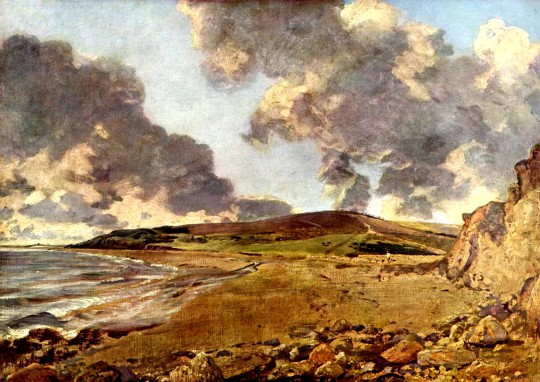
Weymouth Bay by John Constable
A Solitude
Sea beyond sea, sand after sweep of sand,
Here ivory smooth, here cloven and ridged with flow
Of channelled waters soft as rain or snow,
Stretch their lone length at ease beneath the bland
Grey gleam of skies whose smile on wave and strand
Shines weary like a man’s who smiles to know
That now no dream can mock his faith with show,
Nor cloud for him seem living sea or land.
Is there an end at all of all this waste,
These crumbling cliffs defeatured and defaced,
These ruinous heights of sea-sapped walls that slide
Seaward with all their banks of bleak blown flowers
Glad yet of life, ere yet their hope subside
Beneath the coil of dull dense waves and hours?
—Charles Algernon Swinburne
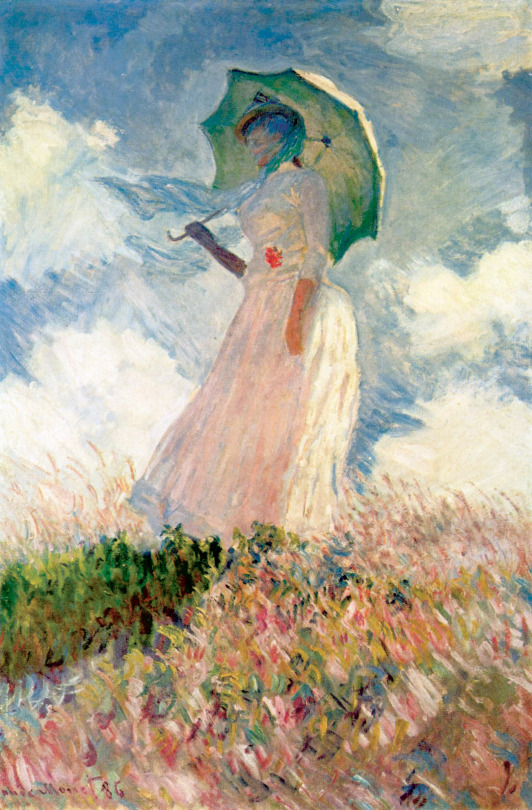
Study of a Figure Outdoors: Woman with a Parasol by Claude Monet
Silent Noon
Your hands lie open in the long fresh grass,—
The finger-points look through like rosy blooms:
Your eyes smile peace. The pasture gleams and glooms
'Neath billowing skies that scatter and amass.
All round our nest, far as the eye can pass,
Are golden kingcup fields with silver edge
Where the cow-parsley skirts the hawthorn-hedge.
'Tis visible silence, still as the hour-glass.
Deep in the sun-searched growths the dragon-fly
Hangs like a blue thread loosened from the sky:—
So this wing'd hour is dropt to us from above.
Oh! clasp we to our hearts, for deathless dower,
This close-companioned inarticulate hour
When twofold silence was the song of love.
—Dante Gabriel Rossetti, from The House of Life

Garden by Claude Monet
#literature#poetry#dark academia#light academia#classic#inspiration#romantic aesthetic#poems and poetry#19th century#romanticism#lord byron#claude monet#victorian art#1800s#solitude#romantic post
3 notes
·
View notes
Text
Towering nearly 6,000 feet, the West Maui Mountains are a dramatic, defining feature of the Hawaiian island—verdant peaks surrounded by sparkling blue waters. But on August 8, they became deadly, helping to unleash hell on the town of Lahaina. Wind poured down the mountains like an avalanche, accelerating to 60-mile-per-hour gusts that got drier and drier as they descended. The winds sucked away the remaining moisture in already parched vegetation, turning the landscape into tinder. Then all it took was a spark.
“When you get 60-mile-an-hour winds, the fact is you're not going to stop any fire, period,” says Jack Minassian, the Fire Science program coordinator at Hawaii Community College. “The only thing that stopped that fire was when it reached the ocean and ran out of fuel. The only thing you do when you have 60-mile-an-hour winds is just get people out of the way.”
Many people couldn’t: The death toll stands at 115, with 850 still reported missing. The worst-case fire scenario that’s played out across the continental United States over recent years—the Camp Fire that destroyed the town of Paradise, killing 85, and the Tubbs Fire that tore through Santa Rosa, killing 22—is now tropical Hawaii’s problem as well. While there is no single reason why wildfires have gotten so bad, a common denominator is wind. And of all the drivers of wildfires, it’s the thing we can’t do anything about.
Long before the winds gusted on August 8, invasive grasses had primed Maui’s landscape to burn. European colonizers brought these with them, when they established plantations on the Hawaiian islands. Those grasses have since spread out of control, covering a quarter of the state—growing across abandoned plantations, along roadsides, between houses. They grow rapidly during the rainy season, and wither quickly during the dry season, which is ongoing right now on Maui. The island is also deep in a drought.
Climate change is helping supercharge these sorts of wind-driven fires. Generally speaking, the hotter the atmosphere gets, the more moisture it can hold, and the more moisture it can remove from vegetation that acts as a fire’s fuel. Scientists are still working to figure out exactly how much climate change contributed to the blaze that destroyed Lahaina, but it’s clear that it is a factor: On a warmer planet, droughts become more common and more intense. Between the years 1920 and 2012, over 90 percent of Hawaii saw a drying trend.
So the grass around Lahaina was ready to burn, and in a matter of hours, those dry winds evaporated what little moisture remained. Think of it like letting your hair air-dry for a while, then blasting it with a hair dryer. The same dynamic is also at play in California’s increasingly catastrophic wildfires: An already-dry landscape can be scoured by winds racing down the Sierra Nevada mountains.
While the source of the ignition for the Lahaina wildfire is still under investigation, electrical infrastructure is the prime suspect. When winds kick up, they jostle wires and can shower dry fuels with sparks. That’s what caused both the Camp and Tubbs fires, among many others in recent years.
Winds blowing at 60 miles an hour not only push the flames along, they also help start new fires. Wildland firefighters on the US mainland regularly struggle with embers blowing miles ahead of the main blaze, starting new ones downwind. The same likely happened across the town of Lahaina, making it impossible to stamp out all the new fires. “That's probably how most of the fires started, from embers accumulating,” says Minassian. “You can see it in some of the pictures there—they show embers all over the place.”
It is exceedingly difficult to predict where winds might drive a fire, because wind is an exceedingly complex phenomenon. It interacts with the landscape in granular ways: It moves differently over grasslands than it does through wooded areas, where it flows between trees. “How is the wind channelized in the gap between two trees? Believe it or not, that actually matters a lot,” says UC Irvine atmospheric scientist Tirtha Banerjee, who studies how wind influences wildfire. “That has an impact on how the fire burns.” And once those winds reached the town of Lahaina, they poured between buildings in complicated ways, further confounding predictions for where the fire might spread.
Climate change is clearly worsening wildfires due to hotter temperatures and gnarlier droughts, and scientists are now trying to work out how it might tweak the way winds flow. “There's a lot more uncertainty because wind is so local, and the small-scale variations on the land surface can really change the patterns,” says Banerjee. “Mountainous terrain can create this little local recirculation that can actually make your fires more unpredictable.”
Indeed, fire behavior—the dynamics of how wildfire spreads across the landscape—is getting increasingly chaotic due to the combination of climate change, accumulated fuels, and wind. That’s making wildfires increasingly difficult to fight. “We've been seeing a lot of really strong, erratic winds that can just make these fires go from something manageable to something that completely levels a town,” says Kaitlyn Trudeau, a senior research associate of climate science at Climate Central, who studies wildfires. “It's been really deadly for a lot of firefighters, who have actually gotten encircled by fire because the winds are just blowing in a way that causes a fire to burn around them into a circle.”
Part of the problem is that as supercharged wildfires get bigger and more intense, they start to create their own wind. Fire produces columns of hot air that rise into the atmosphere—sometimes so much of it that smoke thunderclouds form, creating lightning that sparks more fires. As that hot air ascends, air from surrounding areas rushes in to fill the void, creating additional wind. “It's not like the fire is only responding to the winds, but the fire itself—because of the heat—actually changes the winds,” says climate scientist Ruby Leung, of the Pacific Northwest National Laboratory. “All of this can be very complicated if you want to predict where the winds are blowing.”
There’s simply no controlling the wind—but there are ways to tackle the other drivers of wildfires. In the big picture, humanity needs to dramatically reduce carbon emissions to slow climate change. And in the near term, people need to get better at managing overgrown and dead vegetation, like with controlled burns, so wildfires won’t have the fuel they need to burn out of control. You might have 60-mile-per-hour winds, and you might get a spark from downed electrical lines, but there won't be enough tinder for a fire to turn into a city-obliterating conflagration.
“We're seeing fire seasons getting longer, and we're seeing fire behavior getting more extreme,” says Minassian. “That makes it more difficult to try to suppress. And we need to start thinking about evacuation plans, defensible space, things that communities and homeowners can do to minimize the threat of wildland fire.”
8 notes
·
View notes
Note
5, 7, & 9 (Problematic muses meme)
5. What's makes your muse respect someone? Are they capable of respecting others without reason?
There’s a criterion to earn Roth’s respect, one being humor. He tends to respect people who can handle his humor. If you can handle it, and dish it out, Roth tends to respect that even more.
Roth also tends to respect people for similar beliefs. Roth is counter cultural, individualism and consistently anti-authoritarian. Roth also admires people who actually have virtues. Virtues like honesty, kindness and selflessness tend to earn his admiration.
Though, respect is something Roth does not give out willingly. You gotta prove something to him.
7. Do you ever think that despite your muses actions/morality they do have a point when it comes to their reasons?
Yes, maybe, maybe not.
Firstly, Roth considers himself a prisoner of Hell. A man judged not by God, but by committee. Roth considers his sentencing to be a miscarriage of justice.
Secondly, Roth sees Hell for what it really is, a prison. Yes, it’s far from the inferno of Dante. But everyone is punished and the punishment. In Sarte’s words, Hell is other people. Roth, being more preceptive, sees through Hell’s distractions. Just knowing serves to torture Roth.
Roth also thinks there’s nothing worth his time in Hell. Sure, he’s ignoring his friends and loved ones, but that’s how he feels. Sooner or later, he’s going to lose those people too. So, why even stay? He doesn’t want to become an Overlord. He doesn’t want to make it big and mighty. He doesn’t care about Lucifer, Adam, Lute or that stupid Hotel. He cares about himself and what he wants. What he wants is freedom.
Lastly, Roth believes he deserves more life. Not life below, or in Heaven, but life among the human race. He just wants more time for all his dreams. The places he wants to visit and maybe live in. He wants to dip his hands into the cool waters of The Rubicon. He wants to feel the Sicilian sun on his face. He wants to see wild mustangs in The Sierra Nevada. He wants more LIFE.
That being said, Roth deserved hellfire. He’s made some very serious mistakes. He’s failed people and allowed good people to die.
Sure, Haeven’s committee was heartless. But then again, they were just making their judgement on Roth’s record.
9. What's a line your muse won't cross under any circumstance?
Selling his soul would be one such line. Despite some seductive offers, Roth keeps his soul teethed to him. Sure, they might offer freedom, but Roth is always reading the fine print.
Also, Roth wouldn’t buy anyone’s soul. That’s for Overlords. He’s no overlord, he’s better.
2 notes
·
View notes
Text

Among the Sierra Nevada, California
Albert Bierstadt-1868
4 notes
·
View notes
Text
finding footing in art & nature🦋🌿
This week’s post is about the interpretation of nature through art – I’ll be focusing less on how I interpret nature through art, and more about how I have come to find my footing in doing so.
A quotation from chapter 3 of the textbook (Beck, Cable, & Knudson, 2018) really struck a chord with me for this topic. Talking about studying nature in schools, Burroughs (1916) said that it was:
“Too cold, too special, too mechanical; it is likely to rub the bloom off Nature. It lacks soul and emotion. It misses the accessories of the open air and its exhilarations, the sky, the clouds, the landscape, and the currents of life that pulse everywhere.”
I feel that many of us can relate to this excerpt, as did I. Rub the bloom off Nature.
It sounds silly, and I still sometimes feels pretty embarrassed by it, but I really feel like the driving force behind my choice of major (Zoology) was nature documentaries, photography, and Diane Fossey and Jane Goodall’s stories. The images on a TV screen of people out in the wild, so intimately and genuinely immersed in the beauties and intricacies of nature – that is what drove it home for me.

I can’t honestly say that I was thinking - primarily - about learning the ins and outs of statistical methods. Nor was I considering the how-to’s of data acquisition and manipulation, or even hypothesis formulating.
Realistically, I was thinking about how cool it would be to study a major that was defined by natural historians and explorers like Charles Darwin, or the people I saw on Nat Geo programs.
So… who am I to interpret nature through art? I’m someone in a (to some, surprisingly) technical, scientific major. Someone who didn’t necessarily know what they were signing up for, who was (naively) hoping for an experience akin to these creative interpretations. But I’m someone who has come to love these studies because they’ve immensely deepened the connection I’ve always felt to the beauty of nature. When I see a scenic landscape shot or a charming illustration of anything wild, I have so much more in my interpretive toolset than I ever did before. I can parse through the dramatic editing and enhanced colours to find a deeper meaning, one that is simultaneously more informed and more abstract.
The bloom may have been rubbed off a little, but now I can take steps to paint it back on.
Of course, this need not apply to members of the audience. As the hopeful interpreter, I’m fortunate to have this science + art lens, and it is indeed my responsibility to translate that dual perspective into a single, coherent, and cohesive one.
And how do I interpret the gift of beauty? Through that dual perspective.
One of Tilden’s (1957) Principles of Interpretation is that
“the chief aim of interpretation is not instruction, but provocation”
Philosophers have made attempts through millennia to articulate the importance of beauty. One particularly ephemeral type of beauty has been described as “the sublime”. Crudely, it has to do with the almost agonizing appreciation we feel when we see a mountainscape, the ocean, a sprawling forest – something naturally beautiful, perhaps chaotic, immense (notice that most philosophers can’t help but define it in terms of NATURAL beauty).
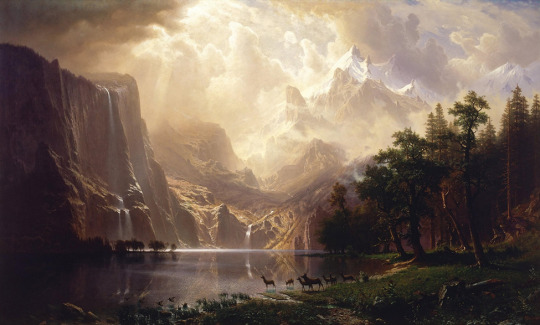
[ Among the Sierra Nevada, California (1868), Albert Bierstadt. ]
Part of the gift of beauty is in its interpretation; the self-reflection that compels us to ask
why is this sight making me feel this way??? and HOW?
Combining that stand-alone beauty with technical knowledge is a simple step we take after being inexplicably provoked by nature. A step towards appreciating, defining, putting our finger on the gorgeous gift that Mother Nature is, and then making our own creations to try to capture that beauty – kind of like how a painter might study a renowned artist by recreating their work. In this way, we gain some insight into how Mother Nature put all these elements together to make a creation so breathtaking.
---
References
Beck, L., Cable, T. T., & Knudson, D. M. (2018). Interpreting Cultural and Natural Heritage for a Better World. Sagamore Publishing.
Burroughs, J. (1916). Under the apple trees. New York, NY: William H. Wise & Co.
Tilden, F. (1957). Interpreting our heritage. Chapel Hill, NC: University of North Carolina Press.
2 notes
·
View notes
Text
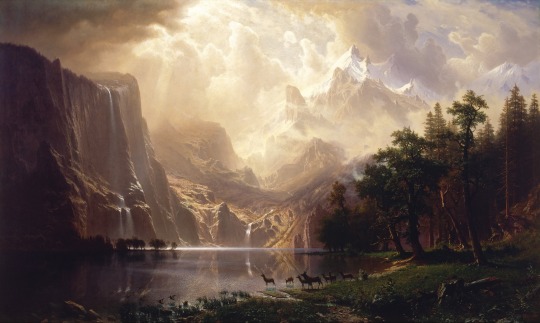
Among the Sierra Nevada, California by Albert Bierstadt
#albert bierstadt#art#sierra nevada#california#america#american#north america#landscape#deers#mountains#mountain#nature#lake#sky#clouds#sunlight
213 notes
·
View notes
Text

Albert Bierstadt | Among the Sierra Nevada, 1868
15 notes
·
View notes
Text
Timothy O'Sullivan

Ancient Ruins in the Cañon de Chelle, N.M. In a niche 50 feet above present cañon bed. - Timothy H. O'Sullivan - 1873

View on Apache Lake, Sierra Blanca Range, Arizona. Two Apache Scouts in the foreground. - Timothy H. O'Sullivan - 1873

Aboriginal Life Among the Navajoe Indians. Near old Fort Defiance, N.M. - Timothy H. O'Sullivan - 1873

Old Mission Church, Zuni Pueblo, N. M. - Timothy H. O'Sullivan - 1873

Section of South Side of Zuni, Pueblo, N. M. - Timothy H. O'Sullivan - 1873

Black Canon, Colorado River, Looking Above from Camp 7 -Timothy H. O'Sullivan - 1871
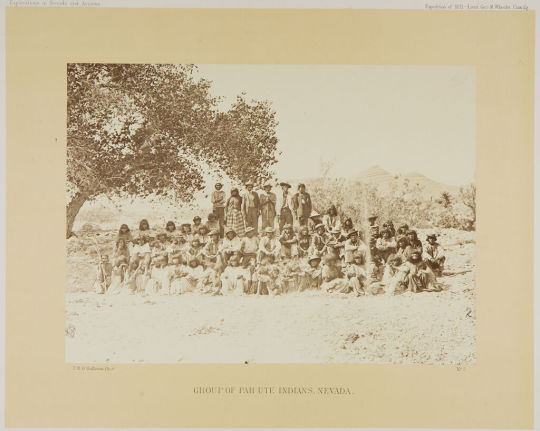
Group of Pah-Ute Indians, Nevada - Timothy H. O'Sullivan - 1871

Mountain transportation. Pack mule, Pack and Packers - Timothy H. O'Sullivan - 1871
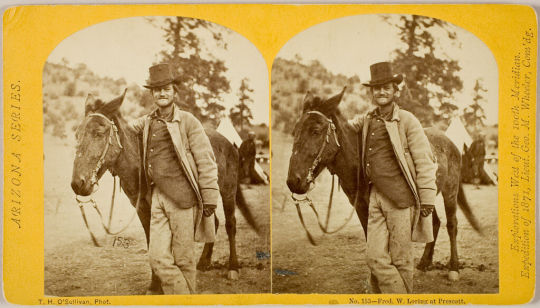
Fred Loring at Prescott, Arizona - Timothy H. O'Sullivan - 1871
2 notes
·
View notes
Photo
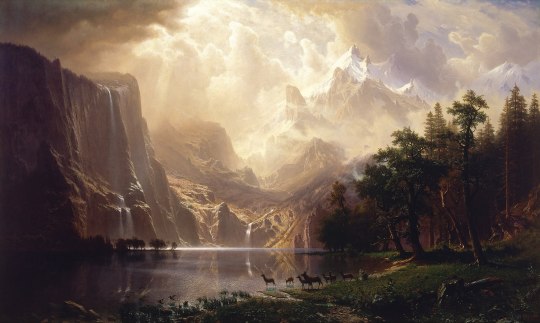
Albert Bierstadt, Among the Sierra Nevada, California, 1868, Smithsonian American Art Museum, Washington, D.C.
7 notes
·
View notes